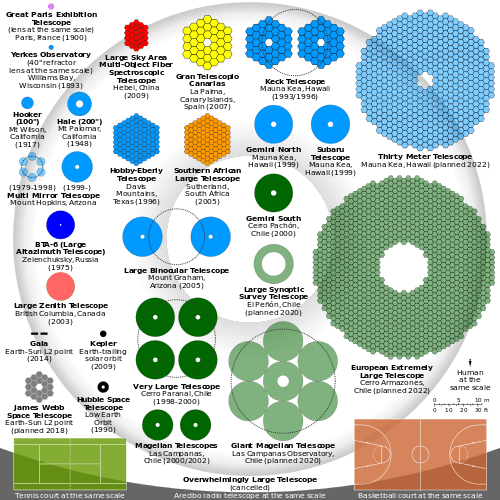Giant Magellan Telescope
 Artwork of Giant Magellan Telescope | |
| Organization | GMT Consortium |
|---|---|
| Location | Las Campanas Observatory, Chile |
| Coordinates | 29°01.7′S 70°41.15′W / 29.0283°S 70.68583°WCoordinates: 29°01.7′S 70°41.15′W / 29.0283°S 70.68583°W |
| Altitude | 2,516 m[1][2] |
| Wavelength | 320–25000 nm[3] |
| Built | Under construction |
| Diameter | 25.448 m[4] (~80 ft.) |
| Angular resolution | 0.21–0.3″ at 500 nm[3] |
| Collecting area | 368 m²[4] |
| Focal length |
18.000 m (M1) 202.745 m (M1+M2)[4] |
| Mounting | altazimuth |
| Website | http://www.gmto.org/ |
The Giant Magellan Telescope (GMT) is a ground-based extremely large telescope planned for completion in 2020.[5] It will consist of seven 8.4 m (27.6 ft) diameter primary segments,[6] with the resolving power of a 24.5 m (80.4 ft) primary mirror and collecting area equivalent to a 22.0 m (72.2 ft) one,[7] (which is about 368 square meters).[4] The telescope is expected to have over five to ten times the light-gathering ability of existing instruments. Three mirrors have been cast and the mountain top is being prepared for construction.[8][9] A total of seven primary mirrors are planned, but it can begin operation with four.[9]
Site

The location of the telescope will be the Las Campanas Observatory,[10] which is also the site of the Magellan Telescopes, some 115 km (71 mi) north-northeast of La Serena, Chile. Much as for previous notable telescopes, the site has been chosen as the new instrument's location because of its outstanding astronomical seeing and clear weather throughout most of the year.[11] Moreover, due to the sparsity of population centers and other favorable geographical conditions, the night sky in most of the surrounding Atacama Desert region is not only free from atmospheric pollution, but in addition it is probably one of the places least affected by light pollution, making the area one of the best spots on Earth for long-term astronomical observation. Major site preparation began with the first blast to level the mountain peak on 23 March 2012.
Mirrors

The telescope will use seven of the world's largest mirrors as primary mirror segments, each 8.417 m (27.61 ft) in diameter. These segments will then be arranged with one mirror in the center and the other six arranged symmetrically around it. The challenge is that the outer six mirror segments will be off-axis, and although identical to each other, will not be individually radially symmetrical, necessitating a modification of the usual polishing and testing procedures.[12]
The mirrors are being constructed by the University of Arizona's Steward Observatory Mirror Lab. The casting of the first mirror, in a rotating furnace, was completed on November 3, 2005, but the grinding and polishing were still going on 6½ years later when the second mirror was cast, on 14 January 2012.[13][14] A third segment was cast in August of 2013.[15][9] After being cast, it needs to cool for about six months.[9] Materials for the fourth mirror segment have been purchased; this mirror was cast in late 2014. The casting of each mirror uses 20 tons of E6 borosilicate glass from the Ohara Corporation of Japan and takes about 12–13 weeks.[8]
Polishing of the first mirror was completed in November 2012.[16] As this was an off-axis segment, a wide array of new optical tests and laboratory infrastructure had to be developed to polish the mirror.
The intention is to build seven identical off-axis mirrors, so that a spare is available to substitute for a segment being recoated, a 1–2 week (per segment) process required every 1–2 years.[17] Although designed for seven mirrors, it can also begin operation with only four mirrors completed.[9]
Although the primary mirror as a whole has a focal ratio (focal length divided by diameter) of f/0.71, the individual segments, being one third that diameter, have a focal ratio of f/2.14.[15] The overall focal ratio is f/8 and the optical prescription is an aplanatic gregorian telescope. The telescope will make use of adaptive optics.[18]
Scientists expect very high quality images of the Universe thanks to 25 metres aperture and most advanced adaptive optics to correct atmosphere distortion. Image quality should exceed even the James Webb Space Telescope.
Organizations
The following organizations are members of the consortium developing the telescope.[19]
- Observatories of the Carnegie Institution of Washington
- University of Chicago
- Harvard University
- Smithsonian Astrophysical Observatory
- Texas A&M University
- University of Arizona
- University of Texas at Austin
- Australian National University
- Astronomy Australia Limited
- Korea Astronomy and Space Science Institute (한국천문연구원)
- University of São Paulo
The Carnegie Observatories office in Pasadena has an outline of the GMT primary mirror array painted in its parking lot. It is easily visible in satellite imagery at 34°09′21″N 118°08′00″W / 34.15591°N 118.13345°W.
Mirror status
- Mirror 1, cast in 2005.[8] Polishing completed with a surface accuracy of 19 nanometers, rms.[16]
- Mirror 2, cast in early 2012, currently undergoing surface processing.[8]
- Mirror 3, cast in August 2013.[8][9]
- Mirror 4, requisite glass ordered, casting planned for late 2014.[8]
See also
- List of optical telescopes and List of largest optical reflecting telescopes
- Magellan telescopes
- Atacama Desert
- Las Campanas Observatory
- Extremely Large Telescope
- Gran Telescopio Canarias
- Thirty Meter Telescope
- European Extremely Large Telescope
References
- ↑ José Terán U.; Daniel H. Neff; Matt Johns (2006-05-29). "SPIE 6267: Symposium on Astronomical Telescopes and Instrumentation". Orlando, Florida: SPIE. p. 2. Retrieved 2008-03-31.
|chapter=ignored (help) - ↑ Joanna Thomas-Osip (2007-03-20), "The Seeing and Turbulence Profile at Las Campanas Observatory: GMT Site Testing Progress Report", Syposium on Seeing, Kona, Hawaii: AAS, p. 3, retrieved 2008-03-31
- ↑ 3.0 3.1 "Giant Magellan Telescope Science Requirements". GMT Consortium. p. 11. Retrieved 2008-03-31.
- ↑ 4.0 4.1 4.2 4.3 "Chapter 6: Optics". GMT Conceptual Design Report. GMT Consortium. p. 6-3. Retrieved 2008-04-02.
- ↑ Joe Palca (2012-01-14), "Mega Mirror To Power Massive New Telescope", All Things Considered, NPR, retrieved 2012-03-23
- ↑ "Giant Magellan Telescope Partner Institutions". GMT Consortium. Retrieved 2007-04-03.
- ↑ Maggie McKee (2007-10-04). "Giant telescope in race to become world's largest". New Scientist. Retrieved 2007-10-07.
- ↑ 8.0 8.1 8.2 8.3 8.4 8.5 Kyle Mittan - Steward Observatory casts second mirror for Giant Magellan Telescope (2012)
- ↑ 9.0 9.1 9.2 9.3 9.4 9.5 Harvard Magazine - Giant Magellan Milestone (2013)
- ↑ "Giant Magellan telescope site selected". Carnegie Institution. Retrieved 2007-10-05.
- ↑ Robinson, Travis (2007-04-03). "Eye on the sky". The Battalion. Retrieved 2007-04-03.
- ↑ What is Optical Metrology?, GMTO, retrieved 2012-04-08
- ↑ Ketelsen, Dean (2012-01-15), GMT polishing at Mirror Lab open house 14 Jan, 2012, retrieved 2012-04-08,
While guests toured the facilities, the Lab staff ran both of our polishing machines on current projects, including this view of final polishing on the first GMT segment.
- ↑ "Mirror Casting Event for the Giant Magellan Telescope" (Press release). GMTO. 2012-01-09.
- ↑ 15.0 15.1 Steward Observatory Mirror Lab, Mirror Castings, retrieved 2012-04-08
- ↑ 16.0 16.1 "World’s Most Advanced Mirror for Giant Telescope Completed". Australian National University. 2012-11-09. Retrieved 2012-01-14.
- ↑ "Telescope Structure". GMT Conceptual Design Report. February 2006. p. 7-17 § 7.4.5. Retrieved 2007-10-07.
The center segment and cell will not have a spare, thus observations will be interrupted every one or two years for the 1–2 week period required to recoat that mirror.
- ↑ "Chapter 2: Overview", GMT Conceptual Design Report, 2006, p. 2-4 § 2.5.1, retrieved 2012-03-25,
GMT is designed from the outset around adaptive optics (AO) with the goal of producing diffraction limited images at 1 m and longer wavelengths.
- ↑ "Giant Magellan Telescope Partner Institutions". GMTO. Retrieved 2009-02-11.
External links
- Giant Magellan Telescope home page
- Lecture by director Patrick McCarthy on technologies behind GMT
- Article from the MIT news office
- New Scientist article on the telescope
- COSMOS article on the telescope
- Painted outline of the mirrors at the parking lot of the Observatories of the Carnegie Institution in Pasadena
- J. Rosenberg - Seeing Stars (2013) - Harvard Magazine
- J. Davis - Making mirrors for the Giant Magellan Telescope (2013) - The Planetary Society